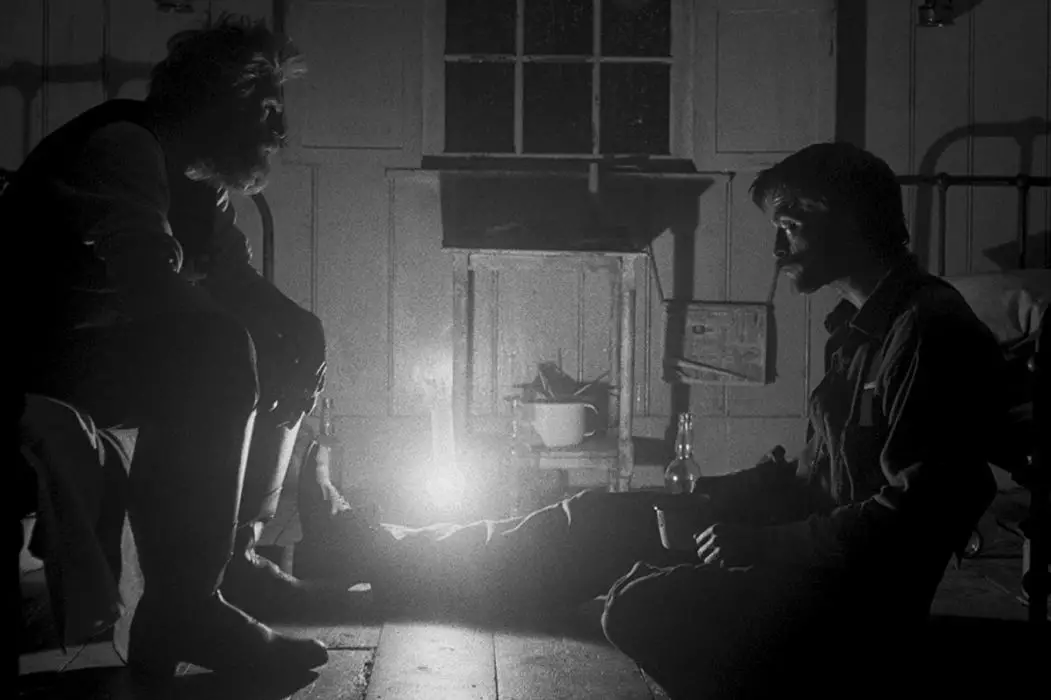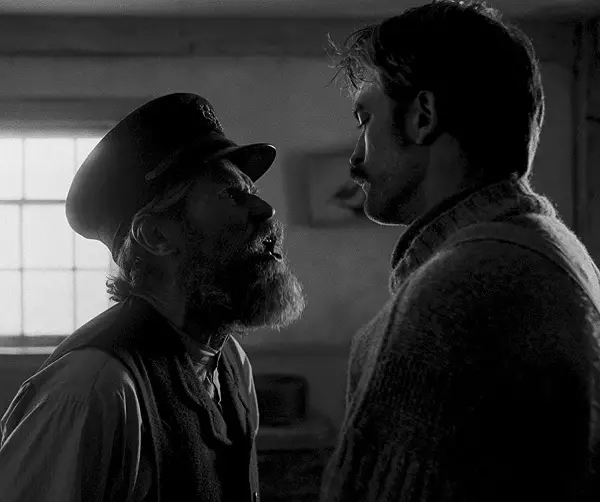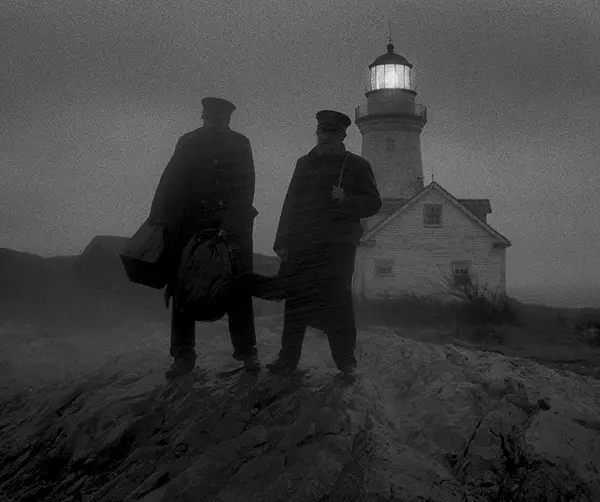THE LIGHTHOUSE: A Saltwater-Soaked Meditation On Madness

Lee Jutton has directed short films starring a killer toaster,…
Director Robert Eggers’ debut feature, The Witch, exploded onto cinema screens in 2015 in a burst of baby blood and billy goats. Shot entirely in natural light and period-appropriate candlelight, with borderline-archaic dialogue that in some instances Eggers had pulled straight from works written at the time, the film’s depiction of a 17th-century family unraveling as a result of witchcraft was all the more terrifying because of how strangely authentic it seemed. While one might not have been alive four hundred years ago to know for sure, Eggers’ attention to every last detail, not to mention his skillful incorporation of iconic imagery from witch folklore, ensured that one felt completely transported to the past while watching it.
Like The Witch, whose subtitle was A New England Folktale, Eggers’ sophomore feature The Lighthouse makes you feel as though you are watching a campfire legend come to life onscreen. Old-fashioned black-and-white cinematography, dialogue rife with sailor slang, and two performances from actors at the peak of their powers draw you into the depths of the spooky story of two lighthouse keepers on a remote island towards the end of the 19th century, and the mysterious things that start happening there. Yet while The Witch was a more traditional horror film with enough appeal for mass audiences, The Lighthouse is another animal entirely, one that is freaky and feral. It’s also one of my favorite films of the year.
Dark and Stormy
Thomas Wake (Willem Dafoe) is a veteran lighthouse keeper who is set to begin a new four-week shift on a remote island alongside a new partner, Ephraim Winslow (Robert Pattinson). Wake is set in his ways and will allow nothing to deter him from his daily routine, which is rife with superstition; when Winslow is reluctant to toast the beginning of their time together, as drinking alcohol is against regulations, Wake harangues him about it being bad luck to turn down a toast until Winslow finally concedes and does so with water (something that is, in itself, bad luck and thought to doom one to a watery grave). Wake is also vehement about the bad luck that will befall anyone who kills a sea bird after he spots Winslow being bullied by one, noting that they “contain the souls of sailors that met their maker.”

The quiet and seemingly straight-laced Winslow is harboring a secret that haunts him daily, and the emotional strain of this previous trauma plays a key role in his mental unraveling. It doesn’t help that Wake’s domineering behavior — forcing Winslow to do menial chores during the day while refusing to let him take a night shift guarding the lighthouse lantern — wears on Winslow’s patience. His unhappiness over not being allowed up the stairs to where the lantern is housed segues first into curiosity (what is he hiding up there?) before becoming all-consuming (I must get up there, no matter the cost!)
When the four weeks are up, Winslow finally succumbs to Wake’s request to have a drink with him. The next morning, instead of being relieved by the next shift, a vicious storm blows in and threatens to maroon the two of them together on the island indefinitely. With little in the way of provisions but a crate of liquor, the mania that comes with being cooped up with one other person seemingly at the end of the world (and an annoying one at that) threatens to utterly overwhelm Winslow.
As the long, lonely days stretch onward and Winslow grows perpetually intoxicated as a method of coping with his desperate situation, it becomes even harder for him to discern fantasy from reality. Is the mermaid (Valeriia Karaman) whose terrifying siren song echoes in his ears a figment of his imagination or a real denizen of the deep? Is that really the severed head of his predecessor in the lobster cage or is his barely submerged paranoia over Wake manifesting itself as a hallucination? Is that a sea monster being kept in the lantern? Is Wake a sea monster himself? Only one thing is for certain: the two men being trapped together in the lighthouse is an increasingly untenable situation and there is no guarantee that both of them will survive.
Out to Sea
The Lighthouse is an incredibly unique, utterly bizarre film, an almost mythic tale that could inspire a sea shanty or five. Nonetheless, in its aftermath I was struck by how much it reminded me, visually and thematically, of two classic explorations of identity and insanity.

The first is Robert Wiene’s 1920 silent film The Cabinet of Dr. Caligari, a masterpiece of silent cinema that relies on visual elements, including dark and twisted set design that verges on the abstract and close-ups of the actor Conrad Veidt’s fascinating visage, to convey the horror and madness at its core. Despite having all of the cinematic tricks the modern era has to offer in his arsenal, Eggers, whose background is in theatrical design, also leans heavily on the visual — and in particular, Pattinson’s striking face, equal parts handsome and haunted — to paint a devastatingly disturbing portrait of one man’s mental unraveling. And considering how difficult it can be to understand some of the film’s grumbly, gritted-teeth dialogue, it’s a method that suits the story of The Lighthouse beautifully.
Shot by Jarin Blaschke (who worked with Eggers on The Witch) on black-and-white 35mm film and in an unusual square ratio (1.19:1, most commonly used by Fox during the early sound era), The Lighthouse resembles early cinema in its framing as well as the content that fills it. This is often Pattinson’s face, centered in the frame in stark, savage close-up, his eyes staring down the lens in increased agony as the film progresses. That the framing is so tight, thanks to its square shape, only emphasizes the claustrophobic nature of Winslow’s predicament and the growing tension between the two men in the lighthouse.
Few actors or cinematographers could pull off such intense, literally in-your-face imagery without it feeling heavy-handed, yet in the capable hands of Pattinson and Blaschke one is reminded how cinema can often be its most impactful when it is stripped down to the bare essentials. After all, who needs CGI when you have Robert Pattinson’s hollow cheekbones? In addition, the use of light and dark — especially dark — only adds to the film’s mystery; some shots are almost entirely black, with light just barely caressing the outline of the human figures in the frame, leaving much to the audience’s imagination.
Pattinson’s performance is the warped, wounded heart of The Lighthouse, and his visually stunning descent into madness is the film’s lifeline. Yet one cannot talk about Pattinson without also paying tribute to his co-star. As the haggard veteran attempting to assert his dominance over his younger colleague, there is no one better you could possibly cast than Willem Dafoe, who conveys both the charm and the menace of Wake with aplomb. When your film focuses on only two characters, you need their performances to be almost symbiotic, and indeed, one knows that The Lighthouse’s deranged storyline only works because of both actors who bring it to life.
Battle of Wills
The other film that I found myself thinking about as the closing credits of The Lighthouse rolled was Ingmar Bergman’s 1966 drama Persona, in which a nurse moves to a remote cabin to care for an actress who has stopped speaking. Over the course of the film, the identities of the two women become increasingly blurred, with Bergman highlighting their similarities in compelling close-ups of their two faces. Some claim Persona shows one personality overcoming and consuming another, while others believe it explores the duality of one woman, personified by these two characters.

These theories remain open to interpretation today, and while to compare Robert Eggers to Ingmar Bergman may be a step too far for many, there are several scenes in The Lighthouse that offer similar opportunities for debate. In moments so brief it’s easy to miss them, Dafoe’s Wake suggests that he does not actually exist, and is a figment of Winslow’s tortured imagination. Wake also attempts to convince Winslow that acts committed by Wake, such as the destruction of a boat Winslow wanted to use to escape the island, were actually committed by Winslow, further emphasizing the increasingly ambiguous state of their identities as the two of them spend more and more time in isolation. While the term gaslighting may be overused as of late, in The Lighthouse, it’s easy to accuse Wake of doing so to Winslow — especially when he implies that his previous partner on the island also went mad.
Being trapped with someone else who may or may not be emotionally manipulating you is, needless to say, a source of great horror, and one that both Persona and The Lighthouse use to maximum effect. And yet, even with these and other resemblances, one cannot accuse The Lighthouse of imitation. Along with other recent breakthrough filmmakers such as Ari Aster, Eggers proves that you can take inspiration from your influences to create something entirely new and exciting. While the films of Aster, Eggers, and others draw heavily on cinematic eras past, they nonetheless contain far more originality (not to mention artistic merit) than most modern-day blockbusters at the multiplex.
The Lighthouse: Conclusion
Like Aster’s Midsommar — another one of my favorite films of the year — I wouldn’t call The Lighthouse a “scary” movie, but it is definitely a haunting and disturbing one, one that will raise goosebumps on your arms as swiftly as a cold breeze off the ocean and keep them there through the film’s tantalizingly bizarre final act. If you’re willing to take a chance and join Eggers, Pattinson, and Dafoe on their very weird journey, you’ll find it’s worth the trip.
What do you think? Does The Lighthouse sound like a worthy follow-up to The Witch? Share your thoughts in the comments below.
The Lighthouse was released in the U.S. on October 18, 2019 and opens in the UK on January 31, 2020. You can find more international release dates here.
Does content like this matter to you?
Become a Member and support film journalism. Unlock access to all of Film Inquiry`s great articles. Join a community of like-minded readers who are passionate about cinema - get access to our private members Network, give back to independent filmmakers, and more.
Lee Jutton has directed short films starring a killer toaster, a killer Christmas tree, and a not-killer leopard. Her writing has appeared in publications such as Film School Rejects, Bitch: A Feminist Response to Pop Culture, Bitch Flicks, TV Fanatic, and Just Press Play. When not watching, making, or writing about films, she can usually be found on Twitter obsessing over soccer, BTS, and her cat.













